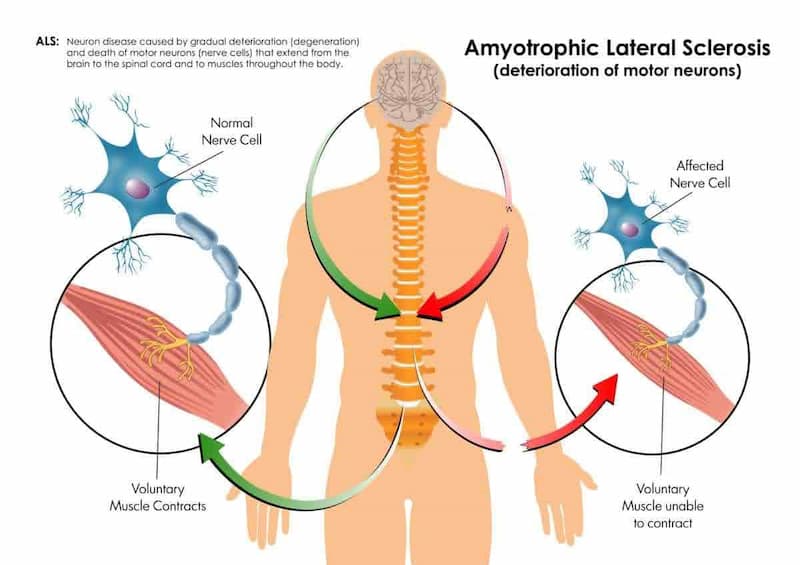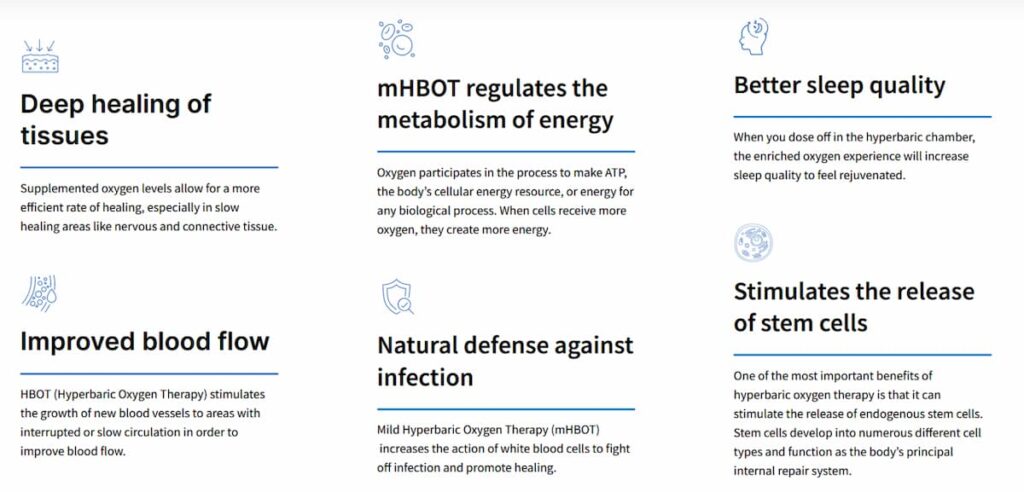Amyotrophic lateral sclerosis (ALS) is a terminal neurodegenerative disease characterized by progressive loss of motor neurons. In ALS, patients tend to suffer from the loss of both upper and lower motor neurons; however, with primary lateral sclerosis and progressive muscular atrophy, patients suffer from either of the two.
Amyotrophic lateral sclerosis is now considered a syndrome rather than a single disease and is deemed incurable because of unknown factors leading to gene mutations. The majority of ALS cases have no clear genetic cause and are categorized as sporadic ALS.

Other factors causing ALS include neuroinflammation, oxidative stress, protein misfolding, and impaired cellular repair mechanisms. Nonetheless, there are several ALS treatment options and therapies that can help manage symptoms and pain, slow down disease progression, and improve the patient’s quality of life.
It’s important to know that while alternative treatments may help improve pain and symptoms, these treatments should be discussed with healthcare providers before engagement. Let’s take a look at lateral sclerosis’s alternative treatment options and therapies that have helped patients manage symptoms and live a more balanced life.
What is ALS?
ALS is a progressive neurodegenerative syndrome that causes excessive degeneration of motor neurons in the cerebral motor cortex, brainstem, and spinal cord. The etiology and underlying mechanisms contributing to ALS development and progression are still unknown.
ALS is also known as Lou Gehrig’s disease, with symptoms involving a lack of muscle control in various parts of the body. The disease starts with muscle twitching and muscle atrophy, leading to severe cases of
- Trouble walking
- Tripping
- Leg and arm weakness
- Slurred speech
- Twitching
- Cognitive and behavioral changes.
Is there treatment for ALS? Yes, certain treatments and therapies help manage worsening symptoms, relieve pain, and slow disease progression. However, no alternative ALS treatment can reverse the progression of the disease or cure it by any means.
Get a free online consultation
Please, contact our medical advisor to discuss your health condition with a specialist in regenerative medicine. You can also leave your contact details for a callback. It is free and confidential.
Alternative treatments for ALS
ALS alternative treatment options, along with conventional medicine, allow the patients to live a more comfortable life while managing symptoms and pain. It is advised to approach these alternative treatments cautiously and discuss their efficacy with medical providers to avoid further health issues. Here are some of the renowned alternative treatment options.
Acupuncture
Acupuncture is one of the most popular therapies in Asian medicine. Acupuncture can help manage symptoms like muscle stiffness or stress; however, acupuncture must be done by a qualified professional to avoid further complications.
Massage therapy
Various massages or relaxation techniques have been found to relieve muscle cramps, tension, and stress caused by diseases among patients.
Nutritional supplements
Nutritional supplements are among the most popular amyotrophic lateral sclerosis alternative treatment options. This includes a tailored diet to help patients maintain weight and overall health, such as creatine, vitamins, and antioxidants.
Meditation and mindfulness practices
Meditation and mindfulness ALS treatment options have potential benefits for individuals in terms of enhancing psychological well-being and supporting symptom management. Meditation can help
- Reduce stress levels
- Manage pain
- Achieve emotional wellbeing
- Improve sleep
- Accept the challenges of the disease.
Yoga and other mindfulness practices
There is no natural cure for Lou Gehrig’s disease; however, yoga and other mindful practices can play a critical role in managing symptoms and slowing down disease progression. Yoga can help improve flexibility, muscle stiffness, and pain relief.
Cannabis and CBD products
The use of cannabis as an ALS alternative medicine treatment is still an area of ongoing research. However, some preliminary studies have shown CBD products to help
- Manage severe pain
- Alleviate muscle spasticity
- Enhance appetite
- Improve sleep quality
- Relive depression and anxiety.
Hyperbaric oxygen therapy

Hyperbaric oxygen therapy is one of the alternative ALS treatment options, where the patient is given pure oxygen in a pressurized chamber. How can ALS be cured by HBOT, and what benefits does it offer to patients?
- HBOT helps compensate for impaired respiratory functions by providing higher oxygen concentrations and increasing oxygen delivery to tissues, which promotes cellular function and repair.
- HBOT has anti-oxidant properties that help reduce oxidative stress and increase the production of anti-oxidant enzymes.
- HBOT has an anti-inflammatory effect on ALS patients by modulating the immune system and mitigating neuroinflammation.
- HBOT also promotes neuroprotection and neuroplasticity among ALS patients.
- HBOT enhances mitochondrial function and mitochondrial biogenesis, thereby improving cellular energy production and reducing neural dysfunction among patients.
Stem cell therapy
Stem cell therapy has emerged as a potential ALS disease alternative treatment because of its inherent ability to aid in replacing a person’s stem cell pool while enhancing the regenerative capacity within the brain and spinal cord. How to cure ALS remains a challenge in the medical field; however, two main types of stem cells largely being used to treat ALS are:
Mesenchymal stem cells
MSCs help treat ALS via their anti-inflammatory and neuroprotective properties. Moreover, their immune modulation effects further help slow down disease progression and protect against further damage to motor neurons.
Neural stem cells
NSCs can enhance stem cells’ regenerative capacity and improve neuromuscular conduction, improving motor functions and slowing disease progression.
Can ALS be cured by stem cells?
Most clinical trials are still investigating the efficacy of stem cells in treating ALS. However, stem cells have been found to slow down disease progression by protecting against further damage to neurons and replenishing motor neurons to preserve muscle functions.
Benefits and risks of alternative treatments
Amyotrophic lateral sclerosis alternative treatment options can help patients manage symptoms and provide supportive care. However, there are both benefits and risks associated with alternative treatments, for instance
- Supplements may help manage symptoms, but their efficacy in slowing down disease progression is still unproven. Moreover, some supplements can react with other medications, leading to side effects.
- Acupuncture and massage therapies have limited supporting evidence in managing ALS symptoms. Furthermore, some techniques can exacerbate muscle weakness, leading to discomfort and pain.
- Cannabis and other CBD products may result in other side effects, such as cognitive impairment, dizziness, and dependence.
- Physical therapy and exercise should be done under the surveillance of professionals to ensure safety and intensity. Over-exertion or improper techniques can cause muscle fatigue, injury, and strains.
Contact us
Get a free online consultation to learn about the expected results of stem cell therapy for your case, what is the cost of the treatment, and its duration.
List of References:
Feldman, E. L., Goutman, S. A., Petri, S., Mazzini, L., Savelieff, M. G., Shaw, P. J., & Sobue, G. (2022). Amyotrophic lateral sclerosis. The Lancet, 400(10360), 1363-1380. DOI: https://doi.org/10.1016/S0140-6736(22)01272-7
Amyotrophic lateral sclerosis (ALS) – Symptoms and causes – Mayo Clinic. (2023, April 25). Mayo Clinic. Available from: https://www.mayoclinic.org/diseases-conditions/amyotrophic-lateral-sclerosis/symptoms-causes/syc-20354022. Accessed (02.04.2024)
Hobson, E., & McDermott, C. J. (2016). Supportive and symptomatic management of amyotrophic lateral sclerosis. Nature Reviews Neurology, 12(9), 526–538. https://doi.org/10.1038/nrneurol.2016.111
D’Antona, S., Caramenti, M., Porro, D., Castiglioni, I., & Cava, C. (2021). Amyotrophic Lateral sclerosis: A Diet Review. Foods, 10(12), 3128. https://doi.org/10.3390/foods10123128
Mensah-Kane, P., & Sumien, N. (2022). The potential of hyperbaric oxygen as a therapy for neurodegenerative diseases. GeroScience, 45(2), 747–756. https://doi.org/10.1007/s11357-022-00707-z
Najafi, S., Najafi, P., Farkhad, N. K., Torshizi, G. H., Darban, R. A., Boroumand, A. R., … & Tavakol-Afshari, J. (2023). Mesenchymal stem cell therapy in amyotrophic lateral sclerosis (ALS) patients. doi: 10.22038/IJBMS.2023.66364.14572
Adams, J., Lee, M., & Peng, W. (2018). Critical Review of Complementary and Alternative medicine use in amyotrophic lateral sclerosis: Prevalence and Users’ Profile, Decision-Making, Information Seeking, and Disclosure in the face of a lack of efficacy. Neurodegenerative Diseases, 18(4), 225–232. https://doi.org/10.1159/000492946
MD, Endocrinologist, Pediatrician, regenerative medicine specialist, R&D director








